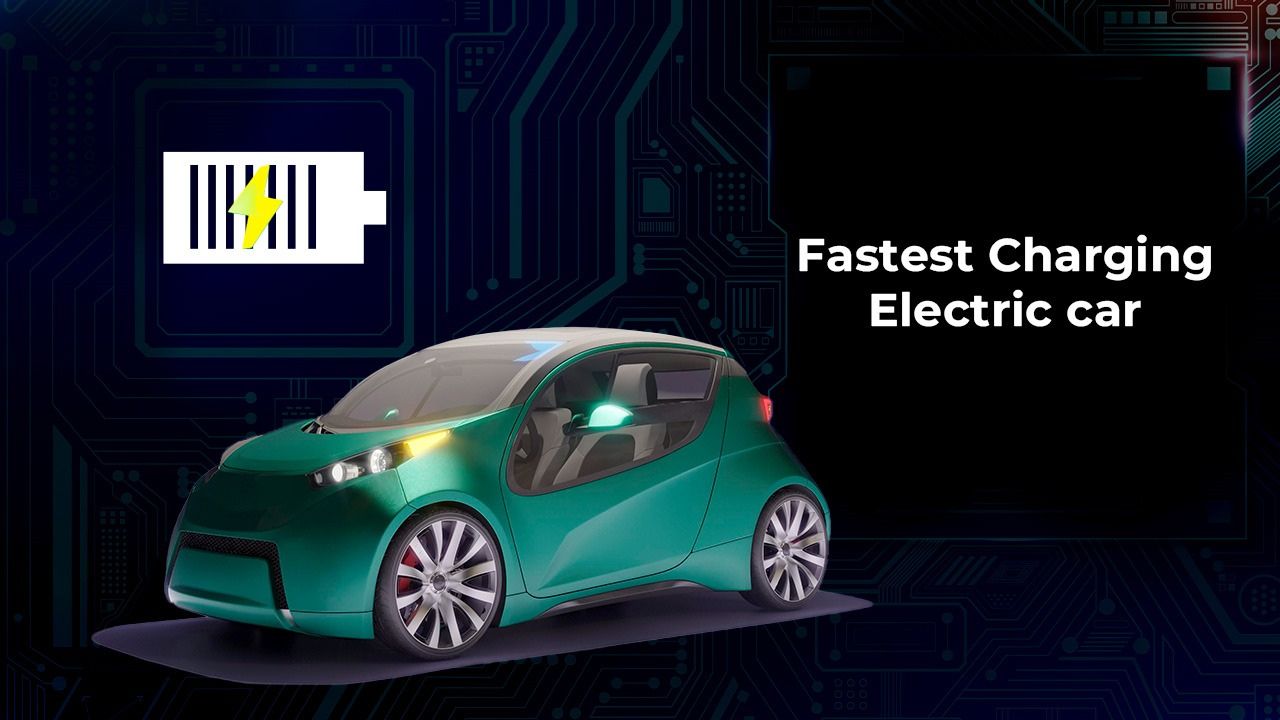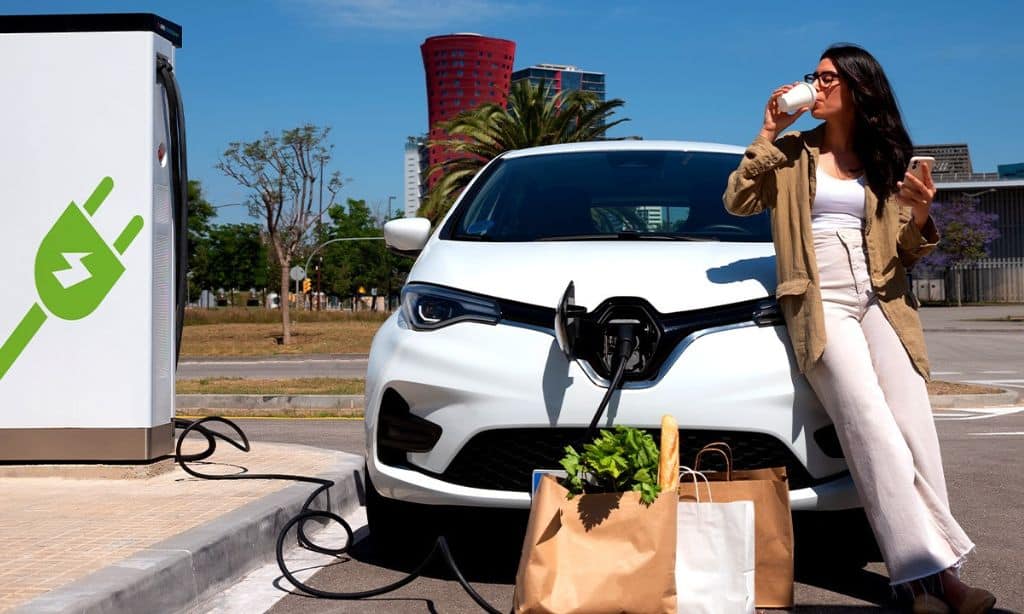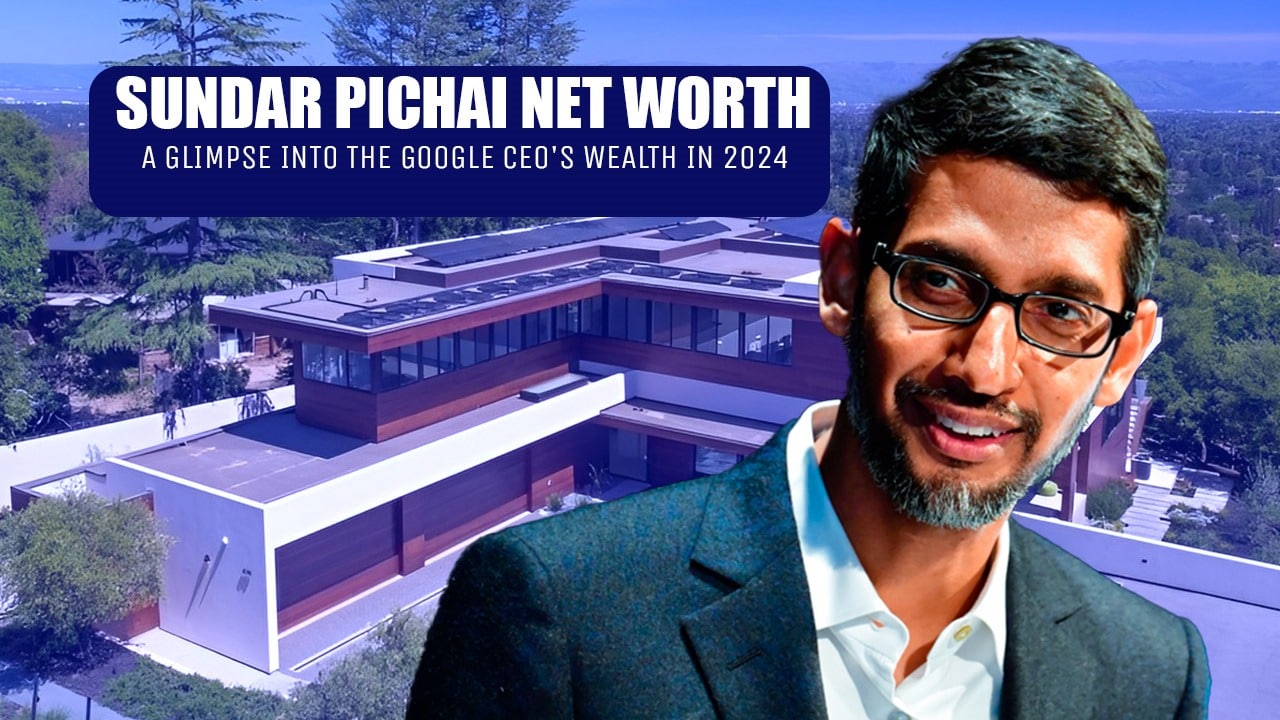Are you thinking of buying the fastest charging electric car but don’t know where to begin? If so, this post is for you! Fast charging technology has drastically improved over the years and now electric car owners can power up their vehicles in minutes rather than hours. 2024 is here and it’s to think in a smarter way. In this article, we’re taking a deep dive into all things related to fast charging from understanding it to identifying the right vehicle that best fits your needs.
We’ll also explain what infrastructure and networks are necessary for fast EV chargers along with highlighting some of the key factors to consider before purchasing a fast-charging EV. All this information plus the latest updates about advancements in DC fast charging technology will equip readers with everything they need when shopping for an electric vehicle.
So let’s get started exploring how you can recharge your way into tomorrow faster!
- Fast charging, also known as Level 3 charging, is the fastest way to charge electric cars. It takes only 30 minutes to 1 hour for a full recharge, making it convenient for drivers.
- Fast chargers use direct current (DC) electricity, skipping the car’s onboard converter. This eliminates energy loss and allows higher amperage, speeding up the charging process.
- Fast charging technology has evolved significantly. Early chargers had a 10 kW output, but current models can provide up to 350 kW. This improvement is due to advances in battery technology and charger construction.
- Different electric cars have different charging times. For example, the 2024 MINI Electric Hardtop takes 4 hours, while the 2023 Ford Mustang Mach-E takes 8.1 hours. These times depend on the car model and battery capacity.
- When choosing an electric car, consider battery technology, compatibility with fast charging networks, and the availability of charging stations. Factors like battery degradation over time and cost concerns should also be taken into account.
Understanding Fastest Charging Electric Car
Electric cars can be recharged by either connecting them to an electric outlet or a charging station. Fast charging, also known as DC fast charging or Level 3 charging is the fastest and most convenient way of powering up an EV’s battery cells, allowing for quick and efficient recharge times between 30 minutes and 1 hour depending on the vehicle.
The technology works by using direct current electricity delivered from a high-powered charger to directly power up the car’s battery pack without needing any additional equipment such as slow-charge adaptors.
By bypassing the car’s onboard AC (alternating current) inverter, which would normally convert household power into usable DC juice for your car, fast chargers eliminate energy loss associated with conversion processes while allowing higher levels of amperage to quickly fill your vehicle’s batteries back up again.
In addition to providing rapid charge times compared to traditional plugging-in methods that utilize low voltage “slow” charging rates, fast chargers require fewer overhead components than normal household outlets due to their strong amps and relatively simple circuitry.
This not only keeps costs down but also allows developers more flexibility when it comes to where they can build new installations without having to worry about fitting specialized 220/240v lines although typically these feature multiple lower-powered outlets too.
The Evolution of Fast Charging Technology
Since its inception, the technology used for fast-charging electric vehicles has progressed significantly. Early high-power chargers boasted a 10 kW power output but current models can now provide as much as 350 kW of energy.
This increase in charging speed has been made possible due to improved battery technology such as the lithium-ion batteries that are now found in most electric cars and advances in DC fast charger construction.
Wireless energy transfer is an emerging approach whereby special pads beneath the car charge it without any plugs or cables attached though this method is only suitable for slow charging at present.
Additionally, some automakers have developed dedicated systems that allow EVs to quickly switch their exhausted battery packs with charged ones from a stand containing multiple interchangeable cells, thus eliminating waiting times altogether and allowing drivers to get back on the road faster.
All these innovations are paving the way forward towards rapid advancement of electrification and greater consideration for sustainability measures within our transportation infrastructure networks.
30 Fastest Charging Electric Cars for 2024
[Video Credit: @FullyChargedShow]
Now we’ll be discussing about the fastest-charging electric car. First look at the table
|
Vehicle |
Charging Time (Level 2) |
Electric Range |
|
2024 MINI Electric Hardtop |
4.0 hours |
114 miles |
|
2023 Mazda MX-30 EV |
5.3 hours |
100 miles |
|
2023 Mercedes-Benz EQB |
5.45 hours |
221-245 miles |
|
2024 Hyundai IONIQ 5 |
5.9 hours |
220-303 miles |
|
2024 Kia Niro EV |
6.08 hours |
253 miles |
|
2024 Hyundai IONIQ 6 |
6.1 hours |
240-361 miles |
|
2023 Tesla Model Y |
6.25 hours |
242-330 miles |
|
2023 Volkswagen ID.4 |
6.25 hours |
209-275 miles |
|
2024 Kia EV6 |
6.3 hours |
218-310 miles |
|
2024 Genesis GV60 |
7.0 hours |
– |
|
2023 Genesis Electrified G80 |
7.4 hours |
282 miles |
|
2023 Chevrolet Bolt EUV |
7.5 hours |
247 miles |
|
2023 Chevrolet Bolt EV |
7.5 hours |
– |
|
2024 Genesis Electrified GV70 |
7.9 hours |
236 miles |
|
2023 Volvo C40 Recharge |
8.0 hours |
226 miles |
|
2023 Ford E-Transit Cargo Van |
8.0 hours |
126 miles |
|
2024 BMW i4 |
8.0 hours |
256-307 miles |
|
2023 Volvo XC40 Recharge |
8.0 hours |
223 miles |
|
2024 Nissan LEAF |
8.0 hours |
150-226 miles |
|
2023 Ford Mustang Mach-E |
8.1 hours |
224-312 miles |
1. 2024 MINI Electric Hardtop
The 2024 MINI Electric Hardtop is a compact two-door hatchback with a distinctive Mini personality. It offers an unmistakable charm, and easy maneuverability, and is particularly well-suited for urban living. Charging time for Level 2 is as low as 4.0 hours, providing an electric range of 114 miles. With a starting price of $31,895, it comes at a lower cost compared to many other electric vehicles. However, potential buyers should consider the limited range in comparison to some competitors and the fact that it doesn’t qualify for the Federal EV tax credit.
2. 2023 Mazda MX‑30 EV
The 2023 Mazda MX-30 EV is a compact crossover with a focus on delivering a fun and quiet driving experience. Charging time for Level 2 is as low as 5.3 hours, providing an electric range of 100 miles. Priced at $38,495, it offers good handling, and a stylish design, and is equipped with features like Apple CarPlay and Android Auto. However, its availability is limited to California, and its driving range falls short compared to other electric vehicles in its class.
3. 2023 Mercedes‑Benz EQB
The 2023 Mercedes-Benz EQB is an electric SUV that prioritizes spaciousness and comfort, making it an excellent choice for small families. With Level 2 charging taking as little as 5.45 hours, it offers an electric range between 221 and 245 miles. Starting at $53,900, the EQB provides quick acceleration, competent handling, and an excellent infotainment system. Potential buyers should be aware of limited third-row passenger space and the presence of hard plastic interior materials.
4. 2024 Hyundai IONIQ 5
The 2024 Hyundai IONIQ 5 is a sporty and practical crossover with various trim options, including a new track-capable N trim. It boasts Level 2 charging in as low as 5.9 hours and an electric range between 220 and 303 miles. Priced at $42,985, it features several new standard safety features and a roomy cabin. However, buyers should consider the below-average cargo area and the fact that it’s not eligible for the federal clean vehicle tax credit.
5. 2024 Kia Niro EV
The 2024 Kia Niro EV is a well-equipped and pleasant-to-drive small electric crossover. With Level 2 charging taking as low as 6.08 hours, it offers an electric range of 253 miles. Priced at $40,925, it provides a comfortable driving experience and a user-friendly infotainment system. However, buyers should note the absence of an all-wheel-drive option and the relatively higher pricing compared to some competitors.
6. 2024 Hyundai IONIQ 6
The 2024 Hyundai IONIQ 6 is a striking electric sedan with a great driving range in rear-wheel-drive models and class-leading efficiency. Charging time for Level 2 is as low as 6.1 hours, offering an electric range between 240 and 361 miles. Priced at $38,615, it features a modern exterior design. However, buyers should be aware that many functions are controlled via touchscreen, and there is tight rear headroom.
7. 2023 Tesla Model Y
The 2023 Tesla Model Y remains a strong contender in the electric SUV category, offering impressive acceleration and lengthy range estimates. With Level 2 charging taking as low as 6.25 hours, it provides an electric range between 242 and 330 miles. Priced at $53,880, it grants access to Tesla’s Supercharger network. However, potential buyers should consider the below-average build quality, a distracting infotainment system, and the absence of phone integration.
8. 2023 Volkswagen ID.4
The 2023 Volkswagen ID.4 has made significant strides in addressing concerns from its previous model year. With the introduction of two new lower-priced trims, Volkswagen aims to make electric driving more accessible. The roomy cabin and abundance of standard features contribute to the ID.4’s appeal, but some users may find certain controls challenging to operate. While it may lack the flashy design and extraordinary power of some competitors, the ID.4 offers a competent crossover experience. Its electric range spans from 209 to 275 miles, and with a starting MSRP of $40,290, it stands as a practical option in the electric vehicle market. The Level 2 charging time is as low as 6.25 hours, adding to the convenience of ownership.
9. 2024 Kia EV6
The 2024 Kia EV6 positions itself as a serious contender in the electric vehicle segment. Boasting luxurious technology and an impressive electric driving range of 218 to 310 miles, the EV6 combines comfort and performance. The Wind AWD trim, starting at $43,925, provides an estimated 106 MPGe in the city and 86 MPGe on the highway. Notably, the Level 2 charging time is as low as 6.3 hours, making charging more efficient and convenient. With an attractive starting market average of $43,799, the EV6 offers a compelling package for those seeking both luxury and sustainability.
10. 2024 Genesis GV60
Genesis introduces the 2024 GV60, a small electric crossover that excels in luxury, driving dynamics, and functionality. Priced competitively, starting at $53,195, the Advanced AWD trim offers an estimated 103 MPGe in the city and 86 MPGe on the highway. The GV60 stands out as the fastest vehicle in the Genesis lineup, featuring sporty handling and a new long-range version. Notably, the Level 2 charging time is as low as 7.0 hours, providing quick and efficient charging. Its luxurious appointments, advanced tech, and compelling styling position it well against competitors like the Audi Q4 e-tron, Ford Mustang Mach-E, Tesla Model Y, and Volvo C40 Recharge.
11. 2023 Genesis Electrified G80
The 2023 Genesis Electrified G80 transforms the well-received G80 3.5T Sport into a midsize luxury sedan with electric power. Priced at $80,950, it offers a sumptuous interior, powerful performance, and a driving range of 282 miles. While lacking direct competitors in its class, the Electrified G80 competes favorably with premium midsize EVs like the Polestar 2 Performance and Tesla Model 3 Performance. Despite its limited availability in 12 states, its combination of luxury and performance makes it a compelling option. The Level 2 charging time is as low as 7.4 hours, ensuring convenient charging options for owners.
12. 2023 Chevrolet Bolt EUV
Chevrolet’s commitment to electric innovation shines through with the 2023 Bolt EUV. This small crossover not only boasts a price cut of over $6K but also delivers an impressive electric range of 247 miles. Priced starting at $28,795, the Bolt EUV offers an exceptional balance of spacious interior and excellent value. The Level 2 charging time for this model is as low as 7.5 hours, providing a convenient charging solution for electric vehicle enthusiasts.
13. 2023 Chevrolet Bolt EV
The 2023 Chevrolet Bolt EV, a sibling to the Bolt EUV, comes with a lower price tag, making it an even more compelling buy at $27,495. Offering a roomy cabin, good range, and starting at a market average of $27,913, the Bolt EV continues to be an engaging option in the electric vehicle market. Like its counterpart, the Bolt EV features a Level 2 charging time of as low as 7.5 hours, contributing to the overall convenience of electric vehicle ownership.
14. 2024 Genesis Electrified GV70
The Genesis Electrified GV70 seamlessly integrates electric power into a platform known for luxury and performance. Its 7.9-hour Level 2 charging time complements the 236-mile electric range, ensuring convenience and efficiency. Boasting a rich interior, smooth acceleration, and quiet operation, this 5-seater SUV delivers a competitive edge. With a 483 combined horsepower, it accelerates from 0 to 60 mph in 3.8 seconds, offering a dynamic driving experience. The Electrified GV70’s innovative approach combines opulence with sustainable performance, positioning it as a compelling choice in the evolving electric vehicle landscape.
15. 2023 Volvo C40 Recharge
The 2023 Volvo C40 Recharge stands out as a premium electric vehicle, emphasizing performance and sophistication. With an 8-hour Level 2 charging time and a 226-mile electric range, it strikes a balance between convenience and competitive mileage. The C40 Recharge provides more choices in its lineup this year, enhancing flexibility for buyers. While it retains Volvo’s signature safety features, some considerations include the absence of Android Auto and limited adaptive cruise availability on lower trims. Overall, it offers zippy performance, a luxurious cabin, and a comfortable ride, contributing to Volvo’s swift transition to an all-electric lineup.
16. 2023 Ford E‑Transit Cargo Van
The 2023 Ford E-Transit Cargo Van marks a significant entry into the electric utility segment, combining powerful electric capabilities with practicality. Its 8-hour Level 2 charging time and 126-mile electric range position it as a versatile choice for businesses. The van’s standout features include a vast cargo capacity, an available onboard power generator, and best-in-class technology and driver-assistance features. While its electric driving range may be shorter than some rivals, the E-Transit Cargo Van caters to eco-conscious businesses, offering an emissions-free work vehicle with modern amenities.
17. 2024 BMW i4
The 2024 BMW i4 marries sporty elegance with diverse electric capabilities, presenting a compelling option in the luxury EV market. With an 8-hour Level 2 charging time and an electric range spanning 256 to 307 miles, the i4 caters to varying preferences. Its stylish and “normal” sedan design distinguishes it from more boldly styled competitors, providing a sleek alternative. Despite considerations such as varying trim prices and cargo capacity, the i4 shines with a cutting-edge infotainment system, impressive performance options, and a range that meets or exceeds many competitors. In the era of electric vehicles, the i4 stands out as a top-tier luxury EV.
18. 2023 Volvo XC40 Recharge
The 2023 Volvo XC40 Recharge, Volvo’s inaugural electric vehicle, maintains its appeal with stylish efficiency and seamless Google integration. Boasting an 8-hour Level 2 charging time and a 223-mile electric range, it brings convenience to electric driving. The XC40 Recharge’s distinctive features include an easy-to-use Google operating system, a visually appealing interior and exterior, and a suite of excellent safety features. While its range may be slightly limited compared to some rivals, and top trims can get expensive, the XC40 Recharge remains a solid choice in the evolving electric SUV landscape, offering a blend of style, technology, and safety.
19. 2024 Nissan LEAF
The 2024 Nissan LEAF continues its legacy as an affordable electric commuter, providing a blend of value and standard features. With an 8-hour Level 2 charging time and an electric range between 150 to 226 miles, the LEAF offers practicality for daily commuting. While competitors may boast more range, the LEAF’s bargain pricing, federal tax credit eligibility, and reliable performance make it an attractive entry into the electric driving world. Despite an aging design, the LEAF stands as a budget-friendly option for those seeking an economical and efficient electric hatchback.
20. 2023 Ford Mustang Mach‑E
The 2023 Ford Mustang Mach-E, a departure from the traditional Mustang, asserts itself as a bold and versatile electric SUV. With an 8.1-hour Level 2 charging time and an electric range spanning 224 to 312 miles, it combines practicality with the Mustang’s iconic design. From the sleek and muscular exterior to the fun-to-drive experience, the Mach-E offers a range of options, including an impressive GT Performance Edition. While some may find its ride firm, the Mach-E delivers on its promise of sporty, efficient performance. As Ford’s entry into the electric era, the Mach-E stands as a distinctive and powerful addition to the electric SUV market.
Factors to Consider When Choosing a Fast-Charging Electric Car
When deciding which electric car to buy, it is important to consider the battery technology, compatibility with fast charging networks and infrastructure, as well as the availability of charging stations.
Battery Technology
The fast-charging capability of electric cars is largely dependent on the battery technology employed. New developments in lithium-ion batteries have led to dramatic improvements in power density, volumetric energy density, and heat management.
Consequently, these new batteries can charge quickly while also being small, light, and long-lasting. Stronger charging protocols such as CCS (Combined Charging System) and CHAdeMO provide higher charge rates for greater convenience but require compatible components within the vehicle itself.
Tesla vehicles equipped with their ‘SuperChargers’ will offer the fastest available charges today where each car requires a different SuperCharger connector applicable only to certain models of electric vehicles made by Tesla or Model S/X EVs fitted with another type of an adapter called “Universal Mobile Connector.”.
In addition to improved battery technology, modern fast-charging systems make use of advanced algorithms that optimize charging speeds based on factors such as temperature fluctuations which helps ensure safety during high amperage discharges.
Compatibility with Fast Charging
Fast charging is an important factor for electric cars as it determines the vehicle’s ability to take advantage of quick and convenient charging. Generally speaking, vehicles with higher-wattage chargers will be able to charge faster than those with lower-wattage chargers.
This holds true even when plugged into a Level 2 charger, though the benefits become more prominent in Level 3 DC fast-charging situations where voltage levels must exceed 150 kW.
High power output requires very particular components that are tailored exactly to an EV’s battery chemistry. That means compatibility is key when it comes to deciding which electric car can offer the fastest possible refueling time for overnight top-ups or trips away from home.
For example, Tesla’s all-electric models from Model S onwards utilize a proprietary charging system called “Supercharger” that enables up to 250 kW of power delivery (5 times faster than most plug socket solutions) through its CCS connection type depending on model specifications.
Availability of Charging Stations
The availability of fast charging stations is a critical factor in the adoption of electric vehicles. Convenient access to sufficient charging infrastructure can help overcome range anxiety and build consumer confidence in these types of cars.
The use of fast charging networks has enabled significant improvements in battery life, making it possible for drivers to quickly recharge their vehicles between trips or even during long-distance journeys.
Fast-charging technologies are now available around the United States, Europe, Asia, and other countries across the world through various electricity providers such as Tesla’s Supercharger Network, Electrify America, and ChargePoint EVgo among others.
Advantages of Fast Charging Electric Cars
Overcoming the traditional limitations of electric vehicles, fast charging technology offers motorists the convenience of quickly recharging their cars and taking advantage of improved range, efficiency, and reduced emissions.
Convenience
When it comes to fast-charging electric cars, convenience is key. Drivers of EVs want the fastest charge possible in order to get back on the road and continue their journey quickly; this can be achieved by plugging into an appropriate fast-charging station.
Fast charging technology reduces the time required to fully recharge a battery, from around 8 hours via slower chargers, down to 20 minutes or less for some vehicles with appropriately configured units. This rapid improvement makes EVs much more efficient and attractive as a viable transportation option that requires less downtime than fueling up at a gas station.
The development of better battery technologies has also contributed significantly towards faster charging times and longer-lasting battery lifetimes; improvements have led manufacturers such as Tesla to increase their production output of powerful batteries designed for superfast charging speeds up to over 200 kilometers per hour (KPH).
Reduced Charging Time
Electric cars have revolutionized the transportation industry, with advancements in battery technology allowing for extraordinary improvements in charging speeds. Fast charge times result from increasingly efficient batteries combined with advances in modern fast-charging infrastructure, signifying a major step forward for the electric vehicle market.
Reduced charging time allows drivers to enjoy increased convenience and reliability when on the road. This means that long trips where rapid charges are needed between destinations can now be completed much faster than ever before in some cases 50% quicker than artificial intelligence-enabled v2 supercharging networks before it.
Improved Range and Efficiency
The fast charging technology used in electric cars has improved the range and efficiency of electric vehicles. This is because a faster charging speed equals more energy stored per unit of time, resulting in higher ranges and overall efficiency.
Advances in battery technology have also played a crucial role in improving energy storage capabilities. Newer lithium-ion batteries offer both higher performance and range than previous generations of battery cells making them well suited for fast charging applications.
Moreover, the expansion of public EV charger networks has enabled longer-distance travel as finding chargers along road trips becomes easier with every new installation or partnership between automakers.
Reduced Carbon Emissions
Electric vehicles have significantly reduced vehicle-related carbon emissions by eliminating the need for gasoline to power engines. This has been particularly useful in helping reduce air pollution and improving overall fuel economy.
According to reports, reducing more than 1 billion tons of CO2 Cf-related emissions is achievable each year through electric transportation when compared with gas-powered cars. Furthermore, research also indicates that electric vehicle fleets are up to four times better than ICE (internal combustion engine) vehicles when it comes to emission levels per kilometer traveled.
When utilizing fast charging technology, electric vehicles can achieve a full charge in just a few minutes’ time as compared with traditional Level 2 or slow mode of charging which takes hours to complete depending on the EV type and battery capacity present inside.
Challenges and Limitations of Fast Charging
Despite the advancements of this technology, there are still some challenges and limitations associated with fast-charging electric cars, including battery degradation over time, cost concerns, and limited availability of charging stations.
Battery Degradation
Fast-charging electric cars are becoming increasingly popular for their ability to reduce the time it takes to charge a car battery, which can be very helpful when drivers need a quick recharge on long journeys.
However, frequent and continued use of fast charging technology can have an adverse effect on battery life, known as ‘battery degradation’. Battery degradation occurs when the capacity of lithium-ion batteries decreases over time due to multiple cycles of recharging at high-speed levels. This manifests itself in slower and shorter charges as well as reduced range and performance from your vehicle’s battery.
Fortunately, advancements in technology are helping to mitigate the effects of battery degradation caused by fast charging. Some manufacturers now produce advanced batteries with solid electrolyte components that help control heat generation during rapid charging as well as adopting cooling systems to further keep temperatures regulated within safe ranges.
Cost
Cost is an important factor to consider when purchasing a fast charging electric car. Initial purchase price will vary depending on the model and features, but may be comparable or even cheaper than conventional cars of similar size; as battery technology continues to improve, prices continue to drop over time.
When it comes to installing the necessary infrastructure for rapid charging, there are additional investments that must be made which can add up quickly and significantly if multiple chargers are needed.
In addition, considerations should also be made regarding ongoing maintenance costs associated with any potential warranty issues in addition to regular tune-ups. Ultimately however, opting for a fast-charging electric car such as the Tesla Model 3 or Porsche Taycan could lead to major savings on fuel costs due to their extended range between charges and increased efficiency compared to traditional gasoline vehicles of the same size.
Limited Availability of Charging Stations
The potential of electric cars is largely dependent on the availability and reliability of charging stations. Currently, there are limited amounts of fast-charging EV stations available to drivers around the world, making them inconvenient for long-distance travel or regular use.
With few public rapid chargers available in many large cities and townships it can often be difficult for an owner to get a charge quickly enough when away from home or work. This makes owning an electric car highly impractical as it places significant limitations on its daily useability, not to mention increases anxiety levels when relying solely on public access points for charging while running errands or traveling beyond one’s local area.
To help address this issue, more governments are beginning to explore funding initiatives that support the development of additional EV infrastructure within their jurisdictions including providing incentives for businesses wishing to install public charging facilities such as supermarkets and restaurants.
Latest Updates and Advancements in Fast Charging Technology
As technology advances, so too does fast charging in electric cars, with new updates and advancements emerging regularly. Read on to discover the latest developments in the sector in 2024.
Improvements in Charging Speed
With advancements in battery and charging technology, the charging speed of electric cars has improved significantly. In some cases, electric cars can now recharge completely within a matter of minutes providing up to 80% charge in as little as 30 minutes.
For example, Tesla’s Supercharger Network has come on leaps and bounds since 2012 and is now capable of delivering up to 250kW per station, providing charge rates that are 6 times faster than traditional chargers.
This means owners can now partially or fully recharge their Model S in only 15-20 minutes – time which many use to grab a quick bite whilst their car charges. Similarly, Hyundai’s first all-electric SUV the Ioniq 5 is also set to be compatible with 350kW fast-charging speeds thanks to the new 800V platform system that was introduced in 2020.
Expansion of Charging Infrastructure
The growth of electric car markets across the world is resulting in an expansion of charging infrastructure, providing more public locations for drivers to refuel their vehicles. According to Global EV Outlook 2023, there was a significant increase of 330,000 fast chargers globally in 2022 with China contributing to almost 90% of that growth despite pandemic-related slowdowns in construction.
By 2030 it is predicted that this number could reach as high as 28 million publicly available charging stations capable of delivering up to 1,400 amps when fully charged but much remains to be done in order for us to achieve wider access and convenience when it comes to powering up our cars.
Integration with Renewable Energy Sources
Integrating electric vehicles (EVs) with renewable energy sources such as wind and solar power can bring environmental benefits that extend beyond a single car, reducing reliance on fossil fuels and making charging infrastructure more sustainable.
For example, incorporating localized renewable capacity into fast charging stations can reduce the reliance of private networks on distant electricity suppliers; additionally, it can help compensate for fluctuations in other power resources.
This integration is becoming increasingly crucial as public EV charging expands networks across cities and global markets grow exponentially.
These efforts not only benefit local electricity grids but also eliminate carbon emissions associated with EV use after all, if electric cars are being charged using clean alternative energy sources rather than burning fossil fuels then their impact on climate change would be significantly reduced.
Moreover, enhanced integration of EVs with residential renewable systems could provide economic advantages in terms of improved reliability in supplying service charges to non-charging customers over time.
Frequently Asked Questions (FAQs)
Now, let’s find out the answers to some questions that people often ask about Fastest charging electric car.
1. What is the fastest electric vehicle to charge?
As of my last knowledge update in January 2022, the fastest charging electric vehicle (EV) was the Porsche Taycan, capable of charging at 270 kW. However, developments in EV technology may have occurred since then. It’s recommended to check the latest information from manufacturers or reliable sources for the most up-to-date details.
3. What is the fastest level of EV charging?
4. What is the fastest electric car time?
The fastest electric car charging time can depend on the charging infrastructure and the vehicle’s capability. As of my last update, the Porsche Taycan was known for its fast charging capability, achieving approximately 62 miles of range in just 4 minutes of charging. However, specific charging times can vary based on factors like the state of charge, battery capacity, and charging station specifications.







































